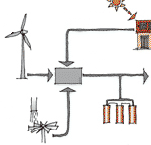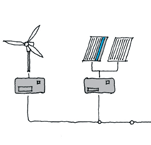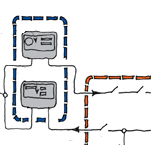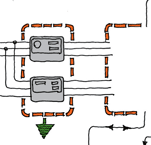Energy
Designing homes to conserve energy and use it efficiently, from sources that cause least environmental harm.
Distributed generation (DG)
With distributed electricity generation systems, property owners generate their own electricity using a system that is also connected to the grid.
On this page:
- how a distributed generation (DG) system works
- requirements for a DG system
- considerations and limitations of DGs
- buy-back arrangements.
How a distributed generation system works
With distributed generation systems, the property owner or a group of property owners generate their own power and also connect into the national grid network. Systems are typically 5 kW or under for a single-phase dwelling and 10 kW or under for a 3-phase dwelling. Groups of dwellings such as retirement villages can be larger.

- Grid-connected, distributed generation system
Security of supply is generally provided by connection to the local electricity network.
The on-site generation is provided by the same means as the stand-alone systems and include:
- solar panels
- wind turbines
- micro-hydro
- micro-CHP (combined heat and power) units
- diesel or petrol generators
- a combination of any of the above.
Requirements for a DG system
The system will need to be installed by a registered electrician, and a certificate of compliance will be required that covers the scope of the installation and confirms its compliance with AS/NZS 4777.2:2020 Grid connection of energy systems via inverters – Part 2: Inverter requirements. The standard specifies minimum performance and safety requirements for “the design, construction and operation of inverters intended for use in inverter energy systems for the injection of electric power through an electrical installation into the grid.” Lists of inverters that meet the requirements of AS/NZS 4777.2:2020 are available – some power distribution companies have them on their websites.
In addition to meeting the specific requirements of AS/NZS 4777.2:2020 and those of the power distribution company the system will be connected to, installations must comply with:
- The Electricity Industry Participation Code 2010 (‘the Code’), in particular Part 6, which covers connection of distributed generation
- The Electricity (Safety) Regulations 2010
- AS/NZS 3000:2018 Electrical installations – Known as the Australian/New Zealand Wiring Rules
- The Resource Management Act 1991
- Any local government rules. Some councils require building consent for PV systems while others don’t.
The distributed generation system must have a number of specific features, such as an isolating switch or circuit breaker that the distribution company’s service teams can access to disconnect the DG system from the lines. The system also needs a meter that separately measures the energy imported and exported. While some houses may have existing smart meters that can do this, others may need their electricity retailer to install a new meter.
AS/NZS 4777.1:2016 Grid connection of energy systems via inverters – Part 1: Installation requirements was published in 30 September 2016. This standard covers design considerations, connection, required documentation and signage, earthing, and some information on electricity distributor requirements.
Considerations and limitations
The mains wiring design and installation for self-generated systems is similar to a normal grid-supplied installation but there are additional mains cable and main board design considerations, such as the inclusion of two-pole lockable isolation.
A disadvantage of distributed generation systems is that the self-generated power supply stops if the national grid fails as the self-generated system must disconnect from the grid so it does not cause lines somewhere else from becoming live during a grid failure.
This situation can be overcome by incorporating a control system that activates the grid connection when the mains power is available but provides power from a battery bank via the inverter when the grid fails.
Buy-back arrangements
A householder wanting to sell surplus electricity they generate will need agreements with both the power distribution (lines) company and the electricity retailer they will be selling the power to. The requirements around buy-back deals are slightly different for systems with capacity 10 kWh or less, and those that are larger. The vast majority of residential installations will be in the smaller bracket (a 10 kWh system could potentially power eight households).
Electricity retailers are not compelled by law to buy power from small suppliers, and they don’t have to provide a fixed-term contract. There is no New Zealand standard or set of rules regulating the small-scale buy-back of electricity. Each retailer sets its own buy-back policy.
Retailers quote their buy-back rates in cents/kWh, the same was as their electricity selling price. Prices can change from time to time – one company’s paperwork gives it the right to change the price with 30 days’ notice.
The Consumer New Zealand Powerswitch website has a page showing the buy-back rates from different retailers. If you or a client are working out which electricity retailer to sign up with, it would be a good approach to consider the buy-back rates along with the website’s calculator that shows the different power plan options available.
Ideally, electricity generated on site should be used on site, and that from photovoltaic systems should be used during the day when the sun is shining. This can be achieved using smart appliances, or using timers or smart plugs that can be set or controlled remotely to operate appliances during the daytime.
Updated: 13 July 2023




